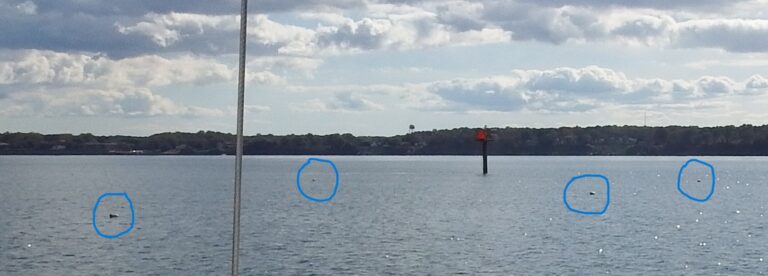Here’s how to measure a sail for replacement. The easy fix is to measure the old sail, but that’s flawed by stretching and shrinking. Plus all three corners have to be pulled tight to get the truth. The only accurate way is to measure the mast and boom. Even then, it’s hard.
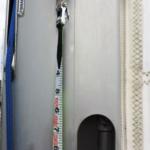 As advised by Doyle in Boston, TAPE measure was tied to Topping Lift and run to the very top of the mast. Calculations below adjust for 1-inch length discrepancy from blue knot to true zero inch mark. (Add an inch.)
As advised by Doyle in Boston, TAPE measure was tied to Topping Lift and run to the very top of the mast. Calculations below adjust for 1-inch length discrepancy from blue knot to true zero inch mark. (Add an inch.)
HEAD PIN shows 3 ½ inches between extreme bottom of pin and the external triangle that protrudes from the mast.
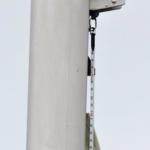 HEAD shows tape reflecting 7 inches at the base of the external triangle. Add 1 inch correction = 8 inches. Add 3 ½ inches from HEAD PIN photo above = 11 ½ inches reduction needed on gross tape measurement, below.
HEAD shows tape reflecting 7 inches at the base of the external triangle. Add 1 inch correction = 8 inches. Add 3 ½ inches from HEAD PIN photo above = 11 ½ inches reduction needed on gross tape measurement, below.
LUFF shows gross tape distance as 36 feet 4 ½ inches to the pin, plus 1 inch correction = 36 feet 5 ½ . (I know this to be true because I pulled a line last week that revealed 36-4 true space available) Now deduct 11 ½ inches from above calculation to yield 35 feet 4 inches. Add 2 inches to round it up to 35-6.
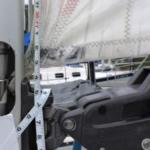 This is longer than the Hunter specs, but more accurate and still allows for nearly a foot stretching over time.
This is longer than the Hunter specs, but more accurate and still allows for nearly a foot stretching over time.
Luff 35-6
LEECH tape measure extends from earlier photo to the clew of the foot. Allow for 1 inch addition in next photo to reflect correction at start of tape measure.
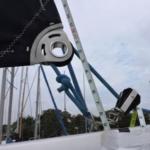 LEECH tape measure arrives at the clew at 36 feet 3 inches. Add 1 inch correction to get 36 feet 4 inches.
LEECH tape measure arrives at the clew at 36 feet 3 inches. Add 1 inch correction to get 36 feet 4 inches.
Leech 36-4
Measuring the foot is easier. Selden pegs it at 12.52 inches but the tape measures it here as 12 feet 8 inches, flush at the mast (not inside it). That’s shy of the 12 feet 11 inches that I ordered erroneously, so it seems reasonable. Hunter specs put the Foot at 12-7. This is also shorter than my erroneous 12-11.
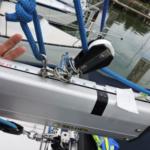 Dilemma 1: Inexplicably the old sail falls well short of these numbers, even when tightened down hard. Not sure what to make of this, since it seems to have shrunk instead of stretched.
Dilemma 1: Inexplicably the old sail falls well short of these numbers, even when tightened down hard. Not sure what to make of this, since it seems to have shrunk instead of stretched.
Foot 12-8
FYI 1: Here’s why the tack loop needs to be three fingers. It’s really difficult to get it inside the mast. (I would love to meet Mr. Selden someday.)
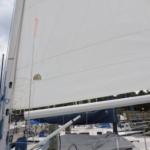 FYI 2: Here’s the angle of the boom to the mast when tightly under sail, maybe 7 degrees.
FYI 2: Here’s the angle of the boom to the mast when tightly under sail, maybe 7 degrees.
Dilemma 2: Even if you measure the Leech at the full 36-10 to the boom (9 inches + 1 correction at top) it still falls short of 38 feet to meet the Pythagorean formula criteria. This may be due to the angle of the boom to the mast.
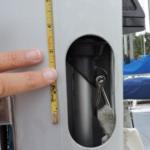 Conclusion
Conclusion
My measurements come close to Pythagorean by yielding Luff 1260 + Foot 161 = 1421, whose square root is 37.7 Leech. The discrepancy probably owes to the angle of the boom.
Let’s Go Sail
Check rates and pick a day for a sailboat charter. See reviews on Trip Advisor.




